Business Finance: Investment Appraisal and Ratio Analysis Case Study
VerifiedAdded on 2023/06/10
|10
|2584
|421
Case Study
AI Summary
This case study provides a comprehensive financial analysis of Jessica Ltd's investment opportunity and Omega Ltd's financial performance. It includes calculations of the payback period, net present value (NPV), and internal rate of return (IRR) to advise Jessica Ltd on the suitability of an online market investment. Furthermore, it calculates and interprets accounting ratios such as current ratio, quick ratio, debt-equity ratio, interest coverage ratio, stock turnover ratio, debtors turnover ratio, creditors turnover ratio and net profit ratio for Omega Ltd, accompanied by a risk assessment based on these ratios. The study also identifies and evaluates non-financial performance indicators like customer satisfaction, retention, and brand reputation for Omega Ltd, and discusses the impact of Salesforce's price skimming strategy on its performance. Desklib provides access to this and many other solved assignments for students.

Business Finance
Paraphrase This Document
Need a fresh take? Get an instant paraphrase of this document with our AI Paraphraser

Table of Contents
MAIN BODY..................................................................................................................................3
2: A Case Study...............................................................................................................................3
Advising Jessica Ltd regarding the suitability of the investment opportunity............................4
b.......................................................................................................................................................5
Calculation of accounting ratios..................................................................................................5
Report of Risk Assessment..........................................................................................................6
Identifying and evaluating non-financial performance indicators for Omega Ltd......................7
Impact of Pricing Strategy on the performance of Salesforce.....................................................8
REFERENCES................................................................................................................................1
MAIN BODY..................................................................................................................................3
2: A Case Study...............................................................................................................................3
Advising Jessica Ltd regarding the suitability of the investment opportunity............................4
b.......................................................................................................................................................5
Calculation of accounting ratios..................................................................................................5
Report of Risk Assessment..........................................................................................................6
Identifying and evaluating non-financial performance indicators for Omega Ltd......................7
Impact of Pricing Strategy on the performance of Salesforce.....................................................8
REFERENCES................................................................................................................................1
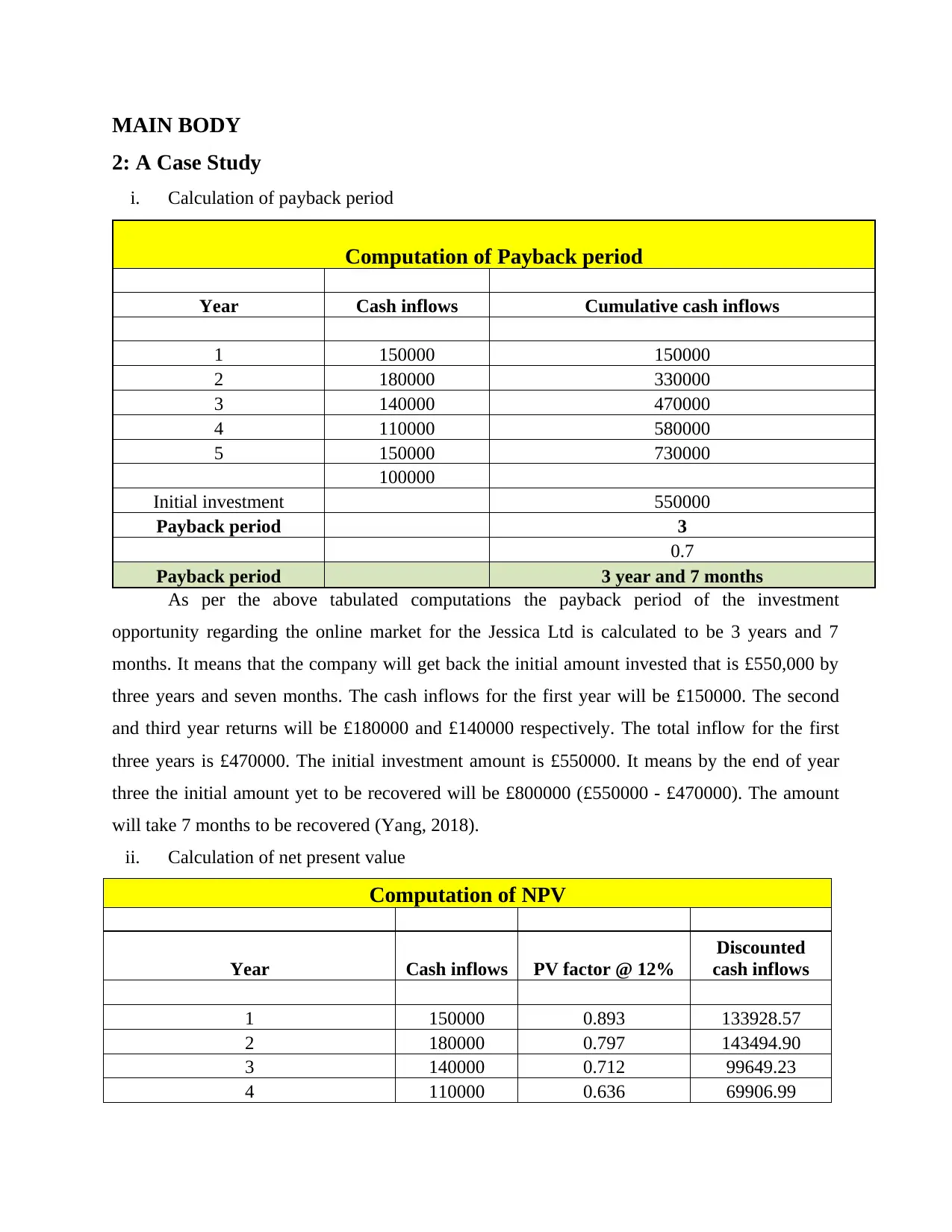
MAIN BODY
2: A Case Study
i. Calculation of payback period
Computation of Payback period
Year Cash inflows Cumulative cash inflows
1 150000 150000
2 180000 330000
3 140000 470000
4 110000 580000
5 150000 730000
100000
Initial investment 550000
Payback period 3
0.7
Payback period 3 year and 7 months
As per the above tabulated computations the payback period of the investment
opportunity regarding the online market for the Jessica Ltd is calculated to be 3 years and 7
months. It means that the company will get back the initial amount invested that is £550,000 by
three years and seven months. The cash inflows for the first year will be £150000. The second
and third year returns will be £180000 and £140000 respectively. The total inflow for the first
three years is £470000. The initial investment amount is £550000. It means by the end of year
three the initial amount yet to be recovered will be £800000 (£550000 - £470000). The amount
will take 7 months to be recovered (Yang, 2018).
ii. Calculation of net present value
Computation of NPV
Year Cash inflows PV factor @ 12%
Discounted
cash inflows
1 150000 0.893 133928.57
2 180000 0.797 143494.90
3 140000 0.712 99649.23
4 110000 0.636 69906.99
2: A Case Study
i. Calculation of payback period
Computation of Payback period
Year Cash inflows Cumulative cash inflows
1 150000 150000
2 180000 330000
3 140000 470000
4 110000 580000
5 150000 730000
100000
Initial investment 550000
Payback period 3
0.7
Payback period 3 year and 7 months
As per the above tabulated computations the payback period of the investment
opportunity regarding the online market for the Jessica Ltd is calculated to be 3 years and 7
months. It means that the company will get back the initial amount invested that is £550,000 by
three years and seven months. The cash inflows for the first year will be £150000. The second
and third year returns will be £180000 and £140000 respectively. The total inflow for the first
three years is £470000. The initial investment amount is £550000. It means by the end of year
three the initial amount yet to be recovered will be £800000 (£550000 - £470000). The amount
will take 7 months to be recovered (Yang, 2018).
ii. Calculation of net present value
Computation of NPV
Year Cash inflows PV factor @ 12%
Discounted
cash inflows
1 150000 0.893 133928.57
2 180000 0.797 143494.90
3 140000 0.712 99649.23
4 110000 0.636 69906.99
⊘ This is a preview!⊘
Do you want full access?
Subscribe today to unlock all pages.

Trusted by 1+ million students worldwide
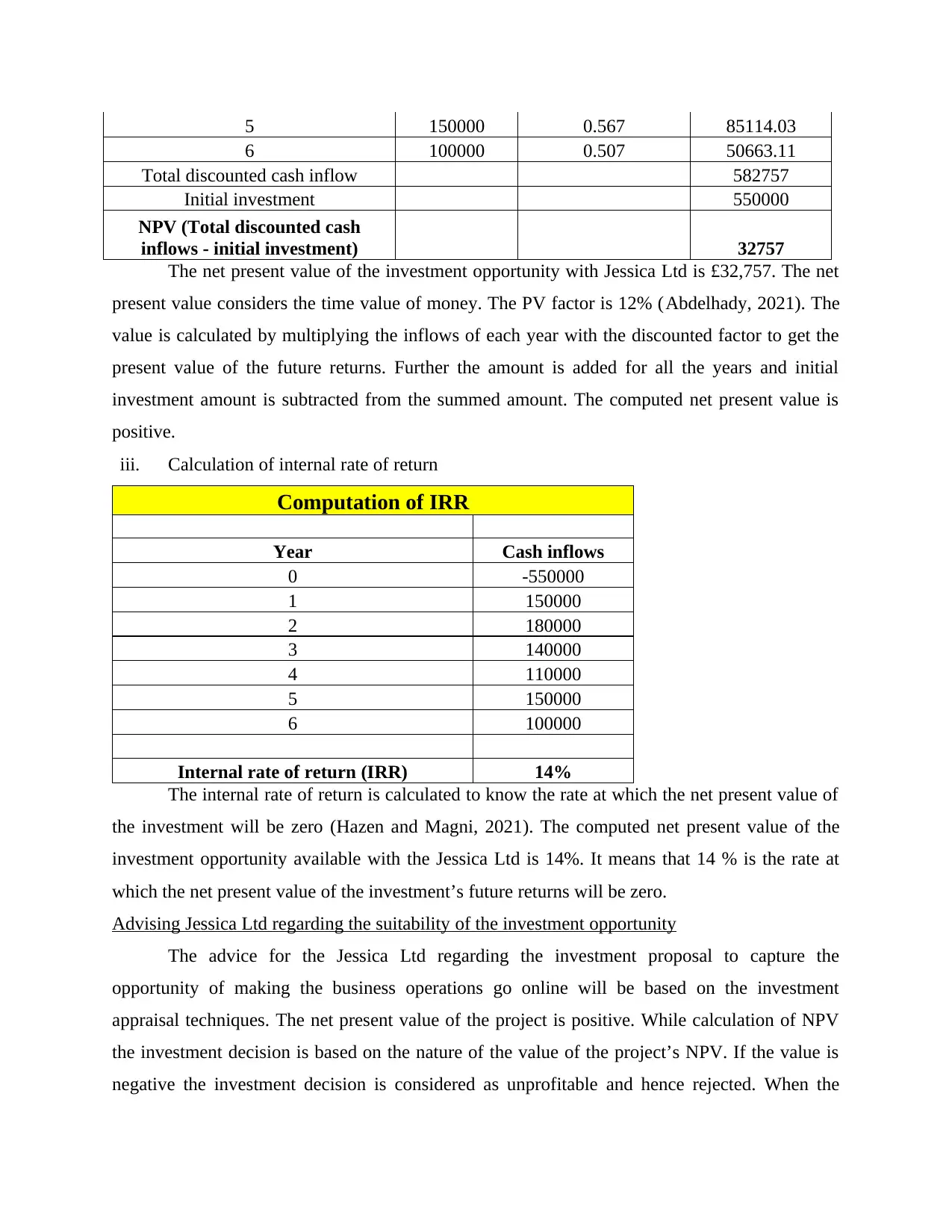
5 150000 0.567 85114.03
6 100000 0.507 50663.11
Total discounted cash inflow 582757
Initial investment 550000
NPV (Total discounted cash
inflows - initial investment) 32757
The net present value of the investment opportunity with Jessica Ltd is £32,757. The net
present value considers the time value of money. The PV factor is 12% (Abdelhady, 2021). The
value is calculated by multiplying the inflows of each year with the discounted factor to get the
present value of the future returns. Further the amount is added for all the years and initial
investment amount is subtracted from the summed amount. The computed net present value is
positive.
iii. Calculation of internal rate of return
Computation of IRR
Year Cash inflows
0 -550000
1 150000
2 180000
3 140000
4 110000
5 150000
6 100000
Internal rate of return (IRR) 14%
The internal rate of return is calculated to know the rate at which the net present value of
the investment will be zero (Hazen and Magni, 2021). The computed net present value of the
investment opportunity available with the Jessica Ltd is 14%. It means that 14 % is the rate at
which the net present value of the investment’s future returns will be zero.
Advising Jessica Ltd regarding the suitability of the investment opportunity
The advice for the Jessica Ltd regarding the investment proposal to capture the
opportunity of making the business operations go online will be based on the investment
appraisal techniques. The net present value of the project is positive. While calculation of NPV
the investment decision is based on the nature of the value of the project’s NPV. If the value is
negative the investment decision is considered as unprofitable and hence rejected. When the
6 100000 0.507 50663.11
Total discounted cash inflow 582757
Initial investment 550000
NPV (Total discounted cash
inflows - initial investment) 32757
The net present value of the investment opportunity with Jessica Ltd is £32,757. The net
present value considers the time value of money. The PV factor is 12% (Abdelhady, 2021). The
value is calculated by multiplying the inflows of each year with the discounted factor to get the
present value of the future returns. Further the amount is added for all the years and initial
investment amount is subtracted from the summed amount. The computed net present value is
positive.
iii. Calculation of internal rate of return
Computation of IRR
Year Cash inflows
0 -550000
1 150000
2 180000
3 140000
4 110000
5 150000
6 100000
Internal rate of return (IRR) 14%
The internal rate of return is calculated to know the rate at which the net present value of
the investment will be zero (Hazen and Magni, 2021). The computed net present value of the
investment opportunity available with the Jessica Ltd is 14%. It means that 14 % is the rate at
which the net present value of the investment’s future returns will be zero.
Advising Jessica Ltd regarding the suitability of the investment opportunity
The advice for the Jessica Ltd regarding the investment proposal to capture the
opportunity of making the business operations go online will be based on the investment
appraisal techniques. The net present value of the project is positive. While calculation of NPV
the investment decision is based on the nature of the value of the project’s NPV. If the value is
negative the investment decision is considered as unprofitable and hence rejected. When the
Paraphrase This Document
Need a fresh take? Get an instant paraphrase of this document with our AI Paraphraser
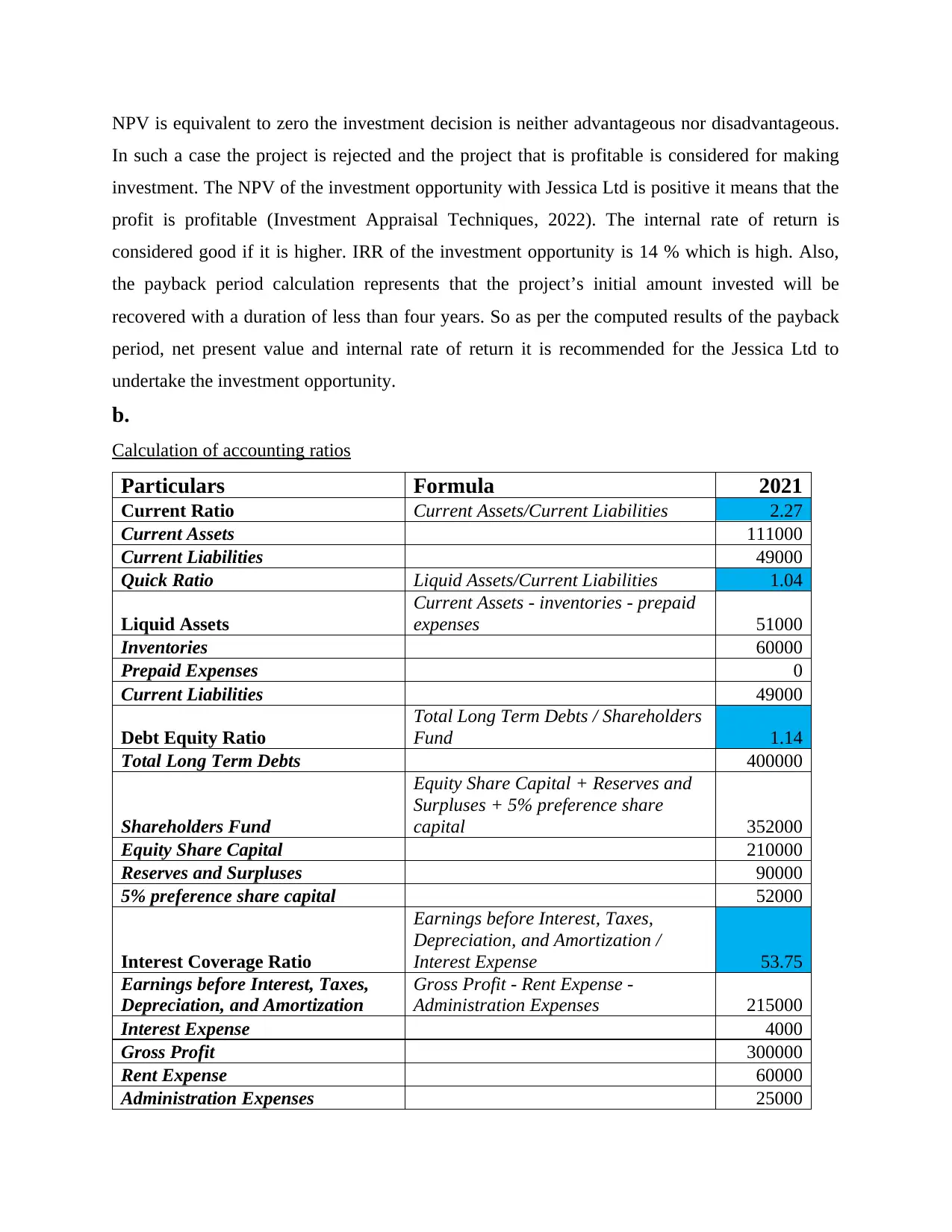
NPV is equivalent to zero the investment decision is neither advantageous nor disadvantageous.
In such a case the project is rejected and the project that is profitable is considered for making
investment. The NPV of the investment opportunity with Jessica Ltd is positive it means that the
profit is profitable (Investment Appraisal Techniques, 2022). The internal rate of return is
considered good if it is higher. IRR of the investment opportunity is 14 % which is high. Also,
the payback period calculation represents that the project’s initial amount invested will be
recovered with a duration of less than four years. So as per the computed results of the payback
period, net present value and internal rate of return it is recommended for the Jessica Ltd to
undertake the investment opportunity.
b.
Calculation of accounting ratios
Particulars Formula 2021
Current Ratio Current Assets/Current Liabilities 2.27
Current Assets 111000
Current Liabilities 49000
Quick Ratio Liquid Assets/Current Liabilities 1.04
Liquid Assets
Current Assets - inventories - prepaid
expenses 51000
Inventories 60000
Prepaid Expenses 0
Current Liabilities 49000
Debt Equity Ratio
Total Long Term Debts / Shareholders
Fund 1.14
Total Long Term Debts 400000
Shareholders Fund
Equity Share Capital + Reserves and
Surpluses + 5% preference share
capital 352000
Equity Share Capital 210000
Reserves and Surpluses 90000
5% preference share capital 52000
Interest Coverage Ratio
Earnings before Interest, Taxes,
Depreciation, and Amortization /
Interest Expense 53.75
Earnings before Interest, Taxes,
Depreciation, and Amortization
Gross Profit - Rent Expense -
Administration Expenses 215000
Interest Expense 4000
Gross Profit 300000
Rent Expense 60000
Administration Expenses 25000
In such a case the project is rejected and the project that is profitable is considered for making
investment. The NPV of the investment opportunity with Jessica Ltd is positive it means that the
profit is profitable (Investment Appraisal Techniques, 2022). The internal rate of return is
considered good if it is higher. IRR of the investment opportunity is 14 % which is high. Also,
the payback period calculation represents that the project’s initial amount invested will be
recovered with a duration of less than four years. So as per the computed results of the payback
period, net present value and internal rate of return it is recommended for the Jessica Ltd to
undertake the investment opportunity.
b.
Calculation of accounting ratios
Particulars Formula 2021
Current Ratio Current Assets/Current Liabilities 2.27
Current Assets 111000
Current Liabilities 49000
Quick Ratio Liquid Assets/Current Liabilities 1.04
Liquid Assets
Current Assets - inventories - prepaid
expenses 51000
Inventories 60000
Prepaid Expenses 0
Current Liabilities 49000
Debt Equity Ratio
Total Long Term Debts / Shareholders
Fund 1.14
Total Long Term Debts 400000
Shareholders Fund
Equity Share Capital + Reserves and
Surpluses + 5% preference share
capital 352000
Equity Share Capital 210000
Reserves and Surpluses 90000
5% preference share capital 52000
Interest Coverage Ratio
Earnings before Interest, Taxes,
Depreciation, and Amortization /
Interest Expense 53.75
Earnings before Interest, Taxes,
Depreciation, and Amortization
Gross Profit - Rent Expense -
Administration Expenses 215000
Interest Expense 4000
Gross Profit 300000
Rent Expense 60000
Administration Expenses 25000
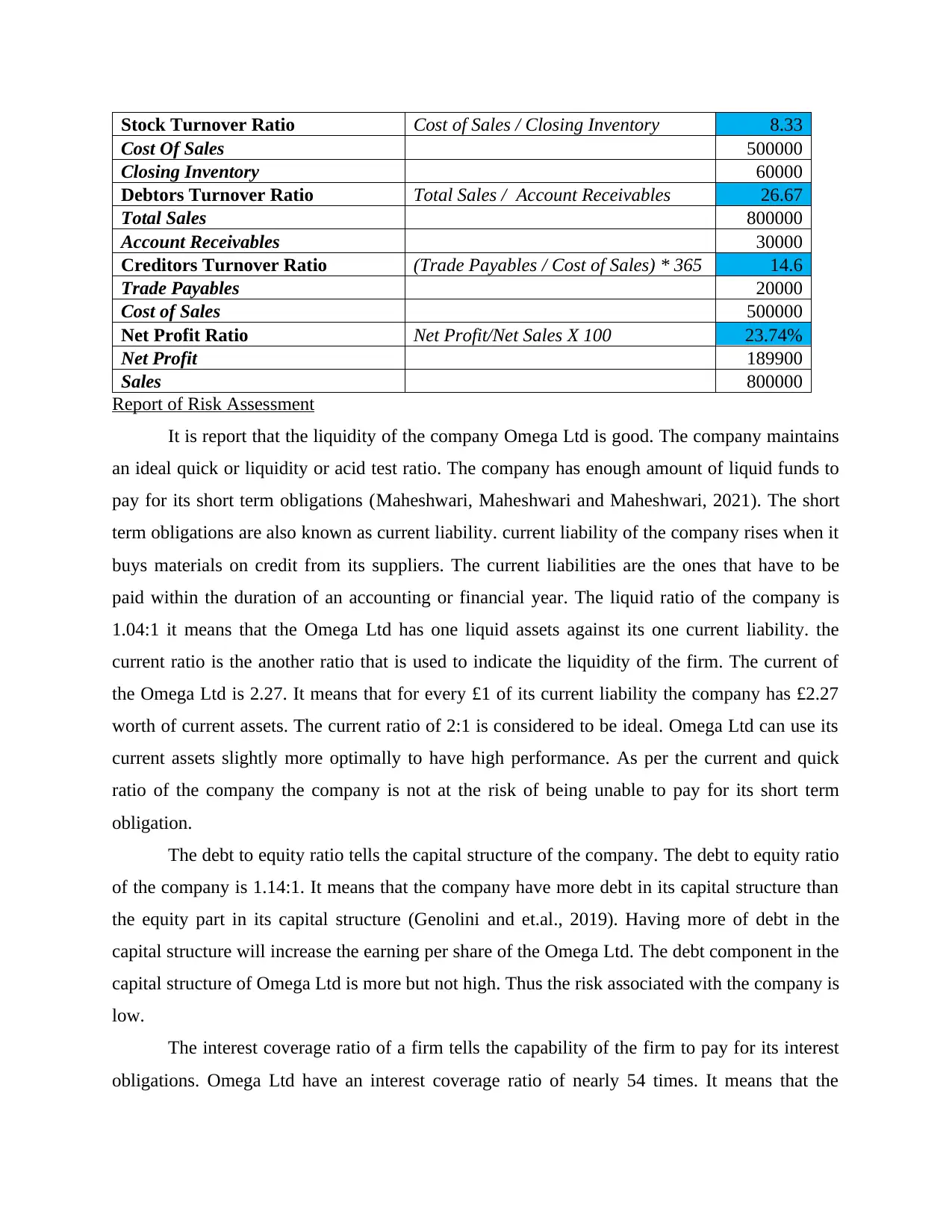
Stock Turnover Ratio Cost of Sales / Closing Inventory 8.33
Cost Of Sales 500000
Closing Inventory 60000
Debtors Turnover Ratio Total Sales / Account Receivables 26.67
Total Sales 800000
Account Receivables 30000
Creditors Turnover Ratio (Trade Payables / Cost of Sales) * 365 14.6
Trade Payables 20000
Cost of Sales 500000
Net Profit Ratio Net Profit/Net Sales X 100 23.74%
Net Profit 189900
Sales 800000
Report of Risk Assessment
It is report that the liquidity of the company Omega Ltd is good. The company maintains
an ideal quick or liquidity or acid test ratio. The company has enough amount of liquid funds to
pay for its short term obligations (Maheshwari, Maheshwari and Maheshwari, 2021). The short
term obligations are also known as current liability. current liability of the company rises when it
buys materials on credit from its suppliers. The current liabilities are the ones that have to be
paid within the duration of an accounting or financial year. The liquid ratio of the company is
1.04:1 it means that the Omega Ltd has one liquid assets against its one current liability. the
current ratio is the another ratio that is used to indicate the liquidity of the firm. The current of
the Omega Ltd is 2.27. It means that for every £1 of its current liability the company has £2.27
worth of current assets. The current ratio of 2:1 is considered to be ideal. Omega Ltd can use its
current assets slightly more optimally to have high performance. As per the current and quick
ratio of the company the company is not at the risk of being unable to pay for its short term
obligation.
The debt to equity ratio tells the capital structure of the company. The debt to equity ratio
of the company is 1.14:1. It means that the company have more debt in its capital structure than
the equity part in its capital structure (Genolini and et.al., 2019). Having more of debt in the
capital structure will increase the earning per share of the Omega Ltd. The debt component in the
capital structure of Omega Ltd is more but not high. Thus the risk associated with the company is
low.
The interest coverage ratio of a firm tells the capability of the firm to pay for its interest
obligations. Omega Ltd have an interest coverage ratio of nearly 54 times. It means that the
Cost Of Sales 500000
Closing Inventory 60000
Debtors Turnover Ratio Total Sales / Account Receivables 26.67
Total Sales 800000
Account Receivables 30000
Creditors Turnover Ratio (Trade Payables / Cost of Sales) * 365 14.6
Trade Payables 20000
Cost of Sales 500000
Net Profit Ratio Net Profit/Net Sales X 100 23.74%
Net Profit 189900
Sales 800000
Report of Risk Assessment
It is report that the liquidity of the company Omega Ltd is good. The company maintains
an ideal quick or liquidity or acid test ratio. The company has enough amount of liquid funds to
pay for its short term obligations (Maheshwari, Maheshwari and Maheshwari, 2021). The short
term obligations are also known as current liability. current liability of the company rises when it
buys materials on credit from its suppliers. The current liabilities are the ones that have to be
paid within the duration of an accounting or financial year. The liquid ratio of the company is
1.04:1 it means that the Omega Ltd has one liquid assets against its one current liability. the
current ratio is the another ratio that is used to indicate the liquidity of the firm. The current of
the Omega Ltd is 2.27. It means that for every £1 of its current liability the company has £2.27
worth of current assets. The current ratio of 2:1 is considered to be ideal. Omega Ltd can use its
current assets slightly more optimally to have high performance. As per the current and quick
ratio of the company the company is not at the risk of being unable to pay for its short term
obligation.
The debt to equity ratio tells the capital structure of the company. The debt to equity ratio
of the company is 1.14:1. It means that the company have more debt in its capital structure than
the equity part in its capital structure (Genolini and et.al., 2019). Having more of debt in the
capital structure will increase the earning per share of the Omega Ltd. The debt component in the
capital structure of Omega Ltd is more but not high. Thus the risk associated with the company is
low.
The interest coverage ratio of a firm tells the capability of the firm to pay for its interest
obligations. Omega Ltd have an interest coverage ratio of nearly 54 times. It means that the
⊘ This is a preview!⊘
Do you want full access?
Subscribe today to unlock all pages.

Trusted by 1+ million students worldwide
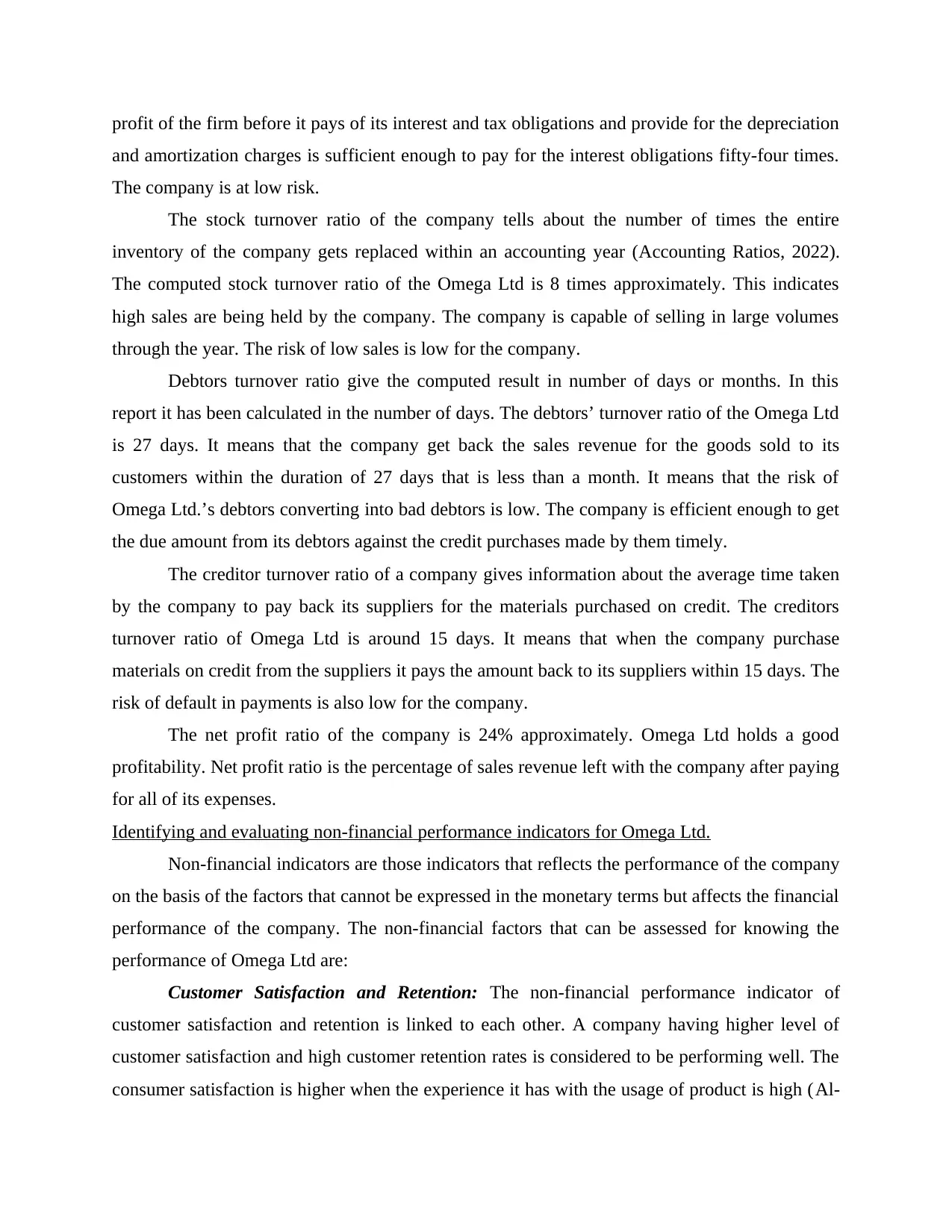
profit of the firm before it pays of its interest and tax obligations and provide for the depreciation
and amortization charges is sufficient enough to pay for the interest obligations fifty-four times.
The company is at low risk.
The stock turnover ratio of the company tells about the number of times the entire
inventory of the company gets replaced within an accounting year (Accounting Ratios, 2022).
The computed stock turnover ratio of the Omega Ltd is 8 times approximately. This indicates
high sales are being held by the company. The company is capable of selling in large volumes
through the year. The risk of low sales is low for the company.
Debtors turnover ratio give the computed result in number of days or months. In this
report it has been calculated in the number of days. The debtors’ turnover ratio of the Omega Ltd
is 27 days. It means that the company get back the sales revenue for the goods sold to its
customers within the duration of 27 days that is less than a month. It means that the risk of
Omega Ltd.’s debtors converting into bad debtors is low. The company is efficient enough to get
the due amount from its debtors against the credit purchases made by them timely.
The creditor turnover ratio of a company gives information about the average time taken
by the company to pay back its suppliers for the materials purchased on credit. The creditors
turnover ratio of Omega Ltd is around 15 days. It means that when the company purchase
materials on credit from the suppliers it pays the amount back to its suppliers within 15 days. The
risk of default in payments is also low for the company.
The net profit ratio of the company is 24% approximately. Omega Ltd holds a good
profitability. Net profit ratio is the percentage of sales revenue left with the company after paying
for all of its expenses.
Identifying and evaluating non-financial performance indicators for Omega Ltd.
Non-financial indicators are those indicators that reflects the performance of the company
on the basis of the factors that cannot be expressed in the monetary terms but affects the financial
performance of the company. The non-financial factors that can be assessed for knowing the
performance of Omega Ltd are:
Customer Satisfaction and Retention: The non-financial performance indicator of
customer satisfaction and retention is linked to each other. A company having higher level of
customer satisfaction and high customer retention rates is considered to be performing well. The
consumer satisfaction is higher when the experience it has with the usage of product is high (Al-
and amortization charges is sufficient enough to pay for the interest obligations fifty-four times.
The company is at low risk.
The stock turnover ratio of the company tells about the number of times the entire
inventory of the company gets replaced within an accounting year (Accounting Ratios, 2022).
The computed stock turnover ratio of the Omega Ltd is 8 times approximately. This indicates
high sales are being held by the company. The company is capable of selling in large volumes
through the year. The risk of low sales is low for the company.
Debtors turnover ratio give the computed result in number of days or months. In this
report it has been calculated in the number of days. The debtors’ turnover ratio of the Omega Ltd
is 27 days. It means that the company get back the sales revenue for the goods sold to its
customers within the duration of 27 days that is less than a month. It means that the risk of
Omega Ltd.’s debtors converting into bad debtors is low. The company is efficient enough to get
the due amount from its debtors against the credit purchases made by them timely.
The creditor turnover ratio of a company gives information about the average time taken
by the company to pay back its suppliers for the materials purchased on credit. The creditors
turnover ratio of Omega Ltd is around 15 days. It means that when the company purchase
materials on credit from the suppliers it pays the amount back to its suppliers within 15 days. The
risk of default in payments is also low for the company.
The net profit ratio of the company is 24% approximately. Omega Ltd holds a good
profitability. Net profit ratio is the percentage of sales revenue left with the company after paying
for all of its expenses.
Identifying and evaluating non-financial performance indicators for Omega Ltd.
Non-financial indicators are those indicators that reflects the performance of the company
on the basis of the factors that cannot be expressed in the monetary terms but affects the financial
performance of the company. The non-financial factors that can be assessed for knowing the
performance of Omega Ltd are:
Customer Satisfaction and Retention: The non-financial performance indicator of
customer satisfaction and retention is linked to each other. A company having higher level of
customer satisfaction and high customer retention rates is considered to be performing well. The
consumer satisfaction is higher when the experience it has with the usage of product is high (Al-
Paraphrase This Document
Need a fresh take? Get an instant paraphrase of this document with our AI Paraphraser
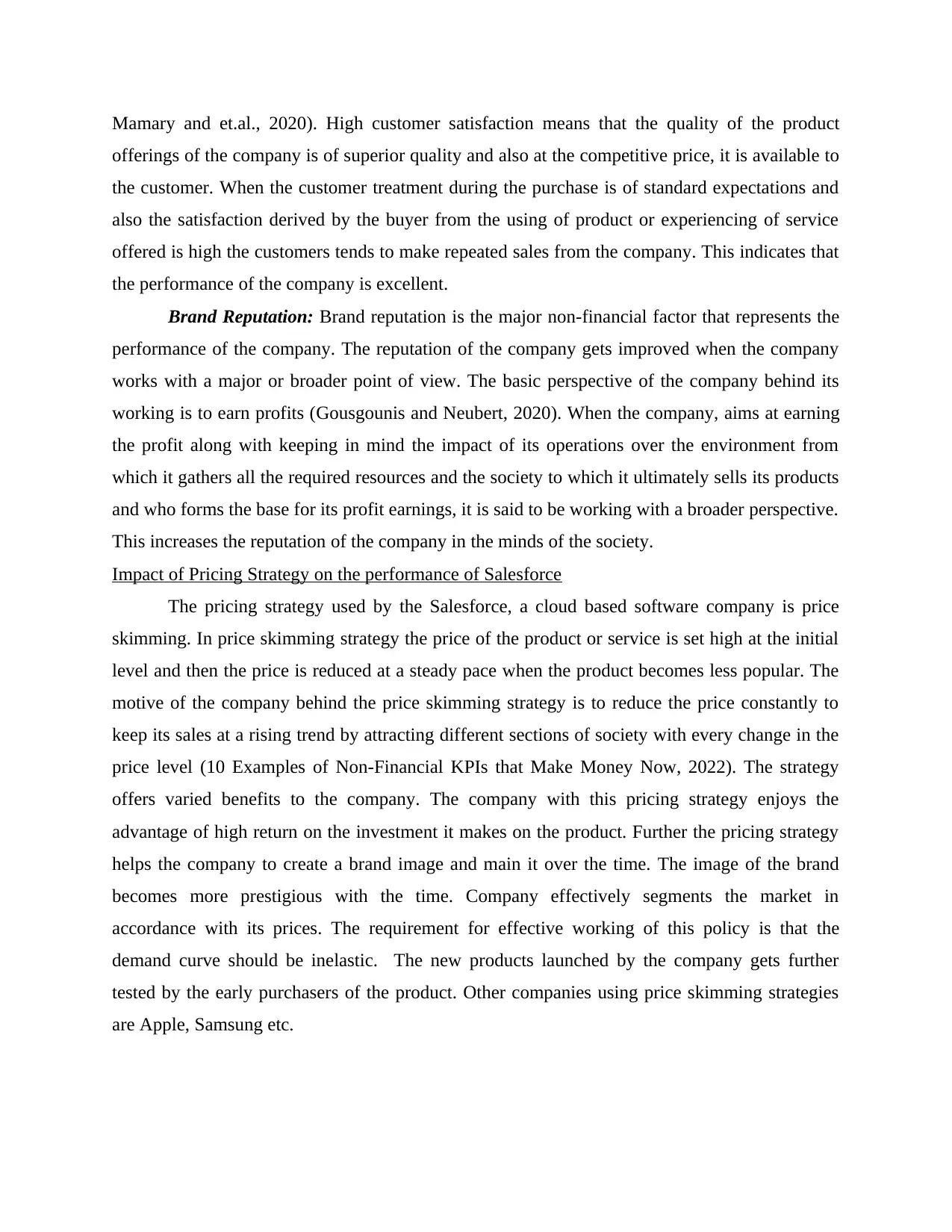
Mamary and et.al., 2020). High customer satisfaction means that the quality of the product
offerings of the company is of superior quality and also at the competitive price, it is available to
the customer. When the customer treatment during the purchase is of standard expectations and
also the satisfaction derived by the buyer from the using of product or experiencing of service
offered is high the customers tends to make repeated sales from the company. This indicates that
the performance of the company is excellent.
Brand Reputation: Brand reputation is the major non-financial factor that represents the
performance of the company. The reputation of the company gets improved when the company
works with a major or broader point of view. The basic perspective of the company behind its
working is to earn profits (Gousgounis and Neubert, 2020). When the company, aims at earning
the profit along with keeping in mind the impact of its operations over the environment from
which it gathers all the required resources and the society to which it ultimately sells its products
and who forms the base for its profit earnings, it is said to be working with a broader perspective.
This increases the reputation of the company in the minds of the society.
Impact of Pricing Strategy on the performance of Salesforce
The pricing strategy used by the Salesforce, a cloud based software company is price
skimming. In price skimming strategy the price of the product or service is set high at the initial
level and then the price is reduced at a steady pace when the product becomes less popular. The
motive of the company behind the price skimming strategy is to reduce the price constantly to
keep its sales at a rising trend by attracting different sections of society with every change in the
price level (10 Examples of Non-Financial KPIs that Make Money Now, 2022). The strategy
offers varied benefits to the company. The company with this pricing strategy enjoys the
advantage of high return on the investment it makes on the product. Further the pricing strategy
helps the company to create a brand image and main it over the time. The image of the brand
becomes more prestigious with the time. Company effectively segments the market in
accordance with its prices. The requirement for effective working of this policy is that the
demand curve should be inelastic. The new products launched by the company gets further
tested by the early purchasers of the product. Other companies using price skimming strategies
are Apple, Samsung etc.
offerings of the company is of superior quality and also at the competitive price, it is available to
the customer. When the customer treatment during the purchase is of standard expectations and
also the satisfaction derived by the buyer from the using of product or experiencing of service
offered is high the customers tends to make repeated sales from the company. This indicates that
the performance of the company is excellent.
Brand Reputation: Brand reputation is the major non-financial factor that represents the
performance of the company. The reputation of the company gets improved when the company
works with a major or broader point of view. The basic perspective of the company behind its
working is to earn profits (Gousgounis and Neubert, 2020). When the company, aims at earning
the profit along with keeping in mind the impact of its operations over the environment from
which it gathers all the required resources and the society to which it ultimately sells its products
and who forms the base for its profit earnings, it is said to be working with a broader perspective.
This increases the reputation of the company in the minds of the society.
Impact of Pricing Strategy on the performance of Salesforce
The pricing strategy used by the Salesforce, a cloud based software company is price
skimming. In price skimming strategy the price of the product or service is set high at the initial
level and then the price is reduced at a steady pace when the product becomes less popular. The
motive of the company behind the price skimming strategy is to reduce the price constantly to
keep its sales at a rising trend by attracting different sections of society with every change in the
price level (10 Examples of Non-Financial KPIs that Make Money Now, 2022). The strategy
offers varied benefits to the company. The company with this pricing strategy enjoys the
advantage of high return on the investment it makes on the product. Further the pricing strategy
helps the company to create a brand image and main it over the time. The image of the brand
becomes more prestigious with the time. Company effectively segments the market in
accordance with its prices. The requirement for effective working of this policy is that the
demand curve should be inelastic. The new products launched by the company gets further
tested by the early purchasers of the product. Other companies using price skimming strategies
are Apple, Samsung etc.

⊘ This is a preview!⊘
Do you want full access?
Subscribe today to unlock all pages.

Trusted by 1+ million students worldwide
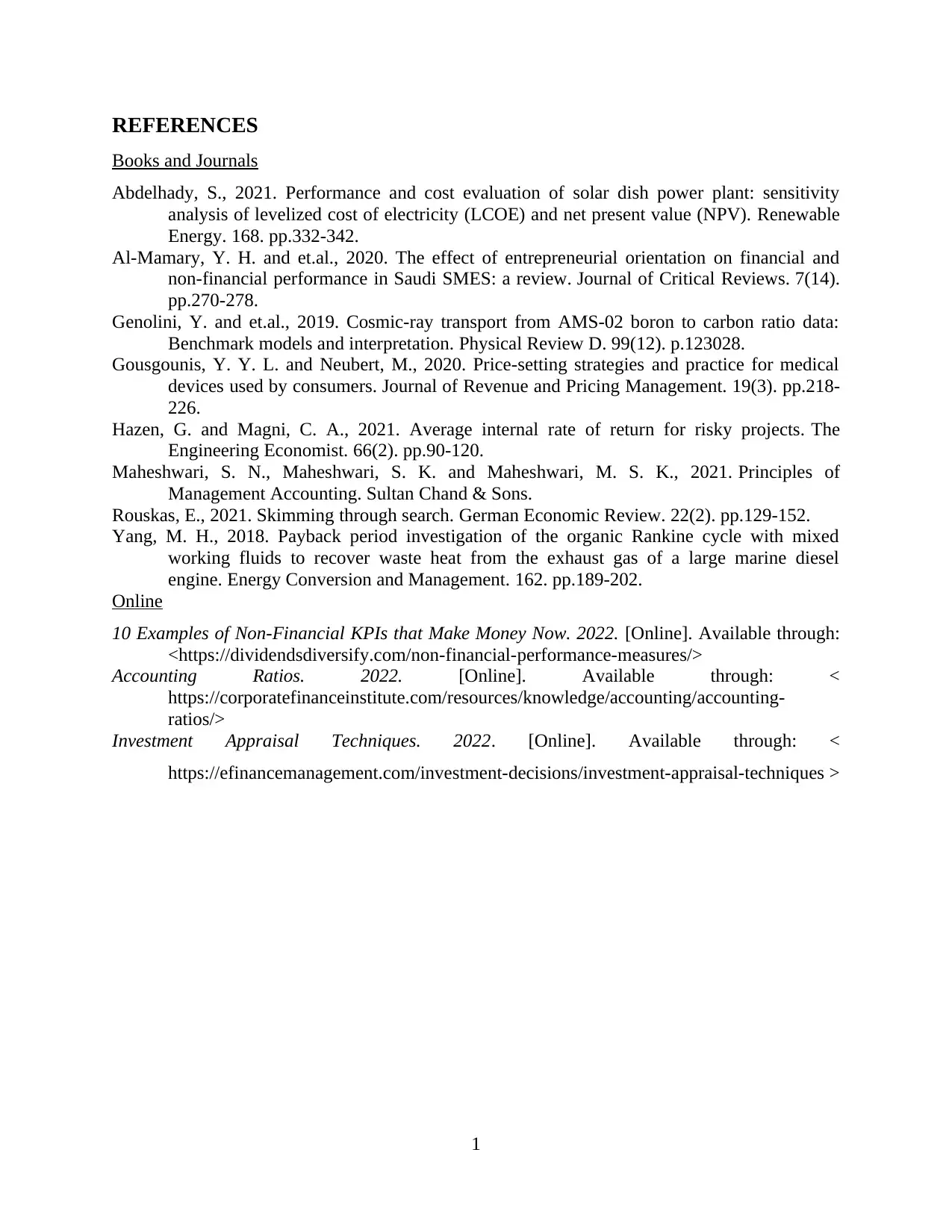
REFERENCES
Books and Journals
Abdelhady, S., 2021. Performance and cost evaluation of solar dish power plant: sensitivity
analysis of levelized cost of electricity (LCOE) and net present value (NPV). Renewable
Energy. 168. pp.332-342.
Al-Mamary, Y. H. and et.al., 2020. The effect of entrepreneurial orientation on financial and
non-financial performance in Saudi SMES: a review. Journal of Critical Reviews. 7(14).
pp.270-278.
Genolini, Y. and et.al., 2019. Cosmic-ray transport from AMS-02 boron to carbon ratio data:
Benchmark models and interpretation. Physical Review D. 99(12). p.123028.
Gousgounis, Y. Y. L. and Neubert, M., 2020. Price-setting strategies and practice for medical
devices used by consumers. Journal of Revenue and Pricing Management. 19(3). pp.218-
226.
Hazen, G. and Magni, C. A., 2021. Average internal rate of return for risky projects. The
Engineering Economist. 66(2). pp.90-120.
Maheshwari, S. N., Maheshwari, S. K. and Maheshwari, M. S. K., 2021. Principles of
Management Accounting. Sultan Chand & Sons.
Rouskas, E., 2021. Skimming through search. German Economic Review. 22(2). pp.129-152.
Yang, M. H., 2018. Payback period investigation of the organic Rankine cycle with mixed
working fluids to recover waste heat from the exhaust gas of a large marine diesel
engine. Energy Conversion and Management. 162. pp.189-202.
Online
10 Examples of Non-Financial KPIs that Make Money Now. 2022. [Online]. Available through:
<https://dividendsdiversify.com/non-financial-performance-measures/>
Accounting Ratios. 2022. [Online]. Available through: <
https://corporatefinanceinstitute.com/resources/knowledge/accounting/accounting-
ratios/>
Investment Appraisal Techniques. 2022. [Online]. Available through: <
https://efinancemanagement.com/investment-decisions/investment-appraisal-techniques >
1
Books and Journals
Abdelhady, S., 2021. Performance and cost evaluation of solar dish power plant: sensitivity
analysis of levelized cost of electricity (LCOE) and net present value (NPV). Renewable
Energy. 168. pp.332-342.
Al-Mamary, Y. H. and et.al., 2020. The effect of entrepreneurial orientation on financial and
non-financial performance in Saudi SMES: a review. Journal of Critical Reviews. 7(14).
pp.270-278.
Genolini, Y. and et.al., 2019. Cosmic-ray transport from AMS-02 boron to carbon ratio data:
Benchmark models and interpretation. Physical Review D. 99(12). p.123028.
Gousgounis, Y. Y. L. and Neubert, M., 2020. Price-setting strategies and practice for medical
devices used by consumers. Journal of Revenue and Pricing Management. 19(3). pp.218-
226.
Hazen, G. and Magni, C. A., 2021. Average internal rate of return for risky projects. The
Engineering Economist. 66(2). pp.90-120.
Maheshwari, S. N., Maheshwari, S. K. and Maheshwari, M. S. K., 2021. Principles of
Management Accounting. Sultan Chand & Sons.
Rouskas, E., 2021. Skimming through search. German Economic Review. 22(2). pp.129-152.
Yang, M. H., 2018. Payback period investigation of the organic Rankine cycle with mixed
working fluids to recover waste heat from the exhaust gas of a large marine diesel
engine. Energy Conversion and Management. 162. pp.189-202.
Online
10 Examples of Non-Financial KPIs that Make Money Now. 2022. [Online]. Available through:
<https://dividendsdiversify.com/non-financial-performance-measures/>
Accounting Ratios. 2022. [Online]. Available through: <
https://corporatefinanceinstitute.com/resources/knowledge/accounting/accounting-
ratios/>
Investment Appraisal Techniques. 2022. [Online]. Available through: <
https://efinancemanagement.com/investment-decisions/investment-appraisal-techniques >
1
1 out of 10
Related Documents
Your All-in-One AI-Powered Toolkit for Academic Success.
+13062052269
info@desklib.com
Available 24*7 on WhatsApp / Email
![[object Object]](/_next/static/media/star-bottom.7253800d.svg)
Unlock your academic potential
Copyright © 2020–2025 A2Z Services. All Rights Reserved. Developed and managed by ZUCOL.





